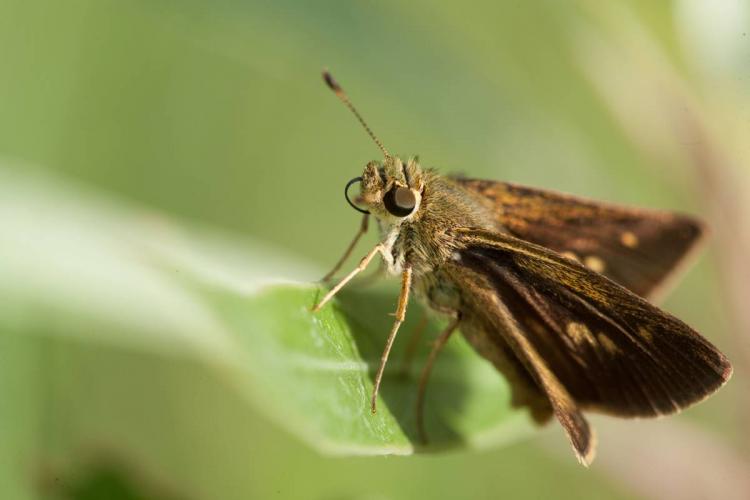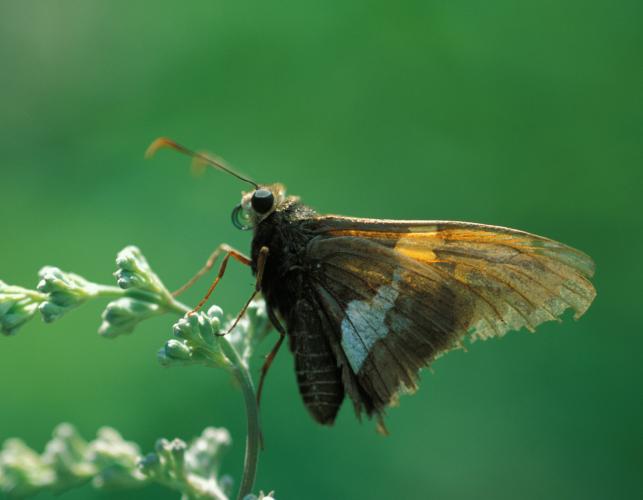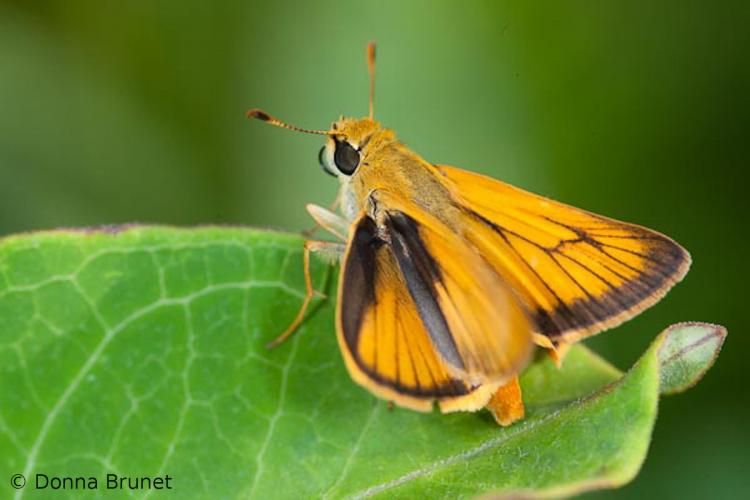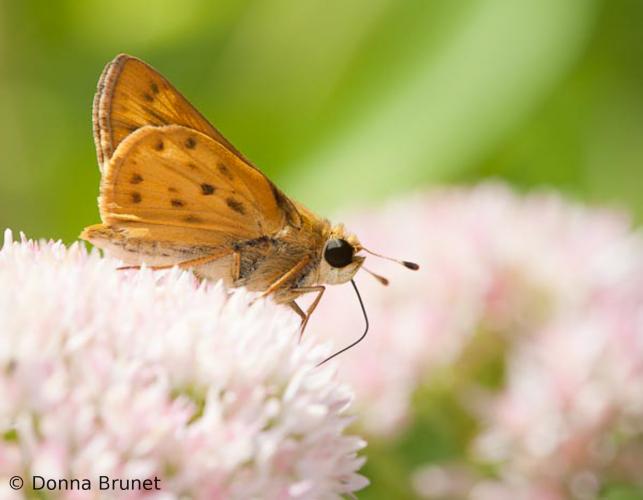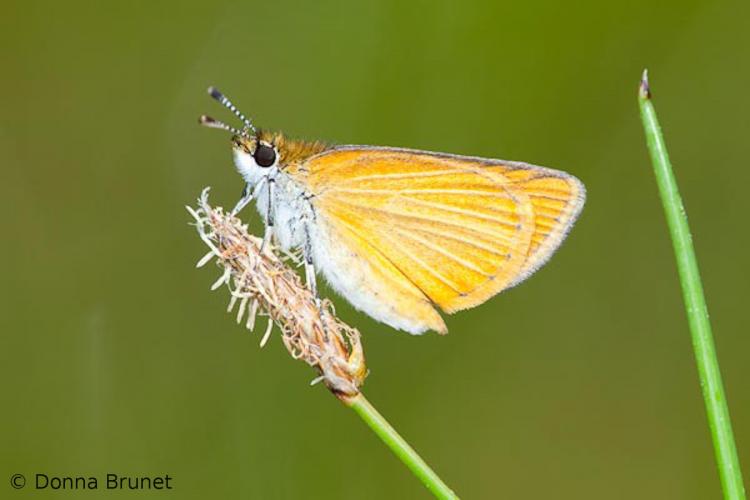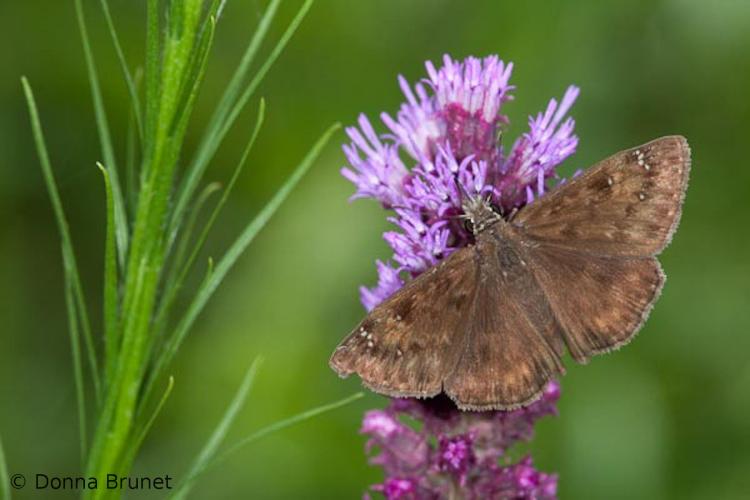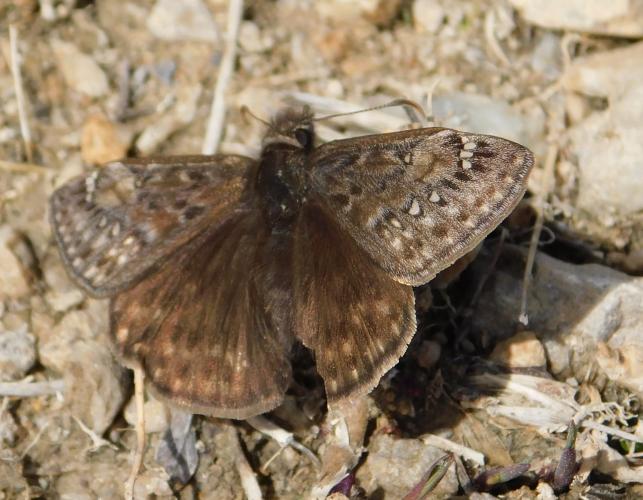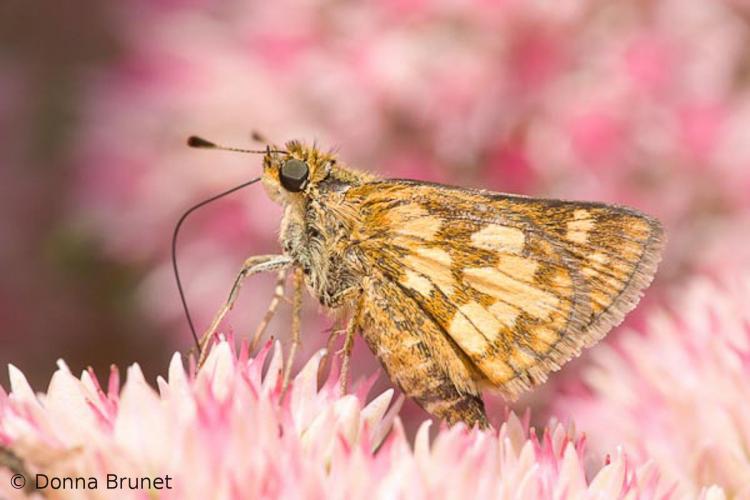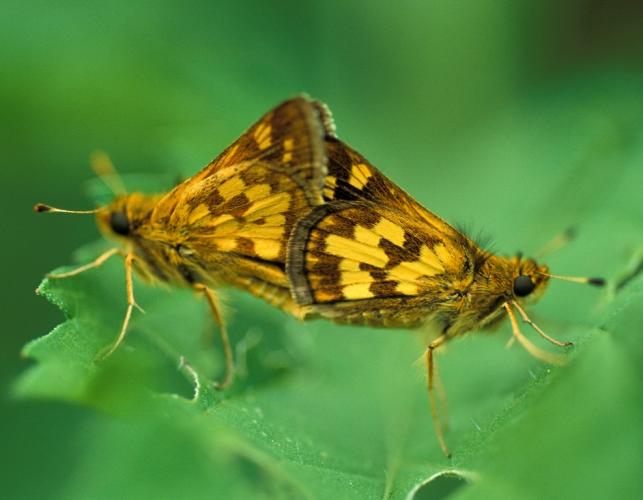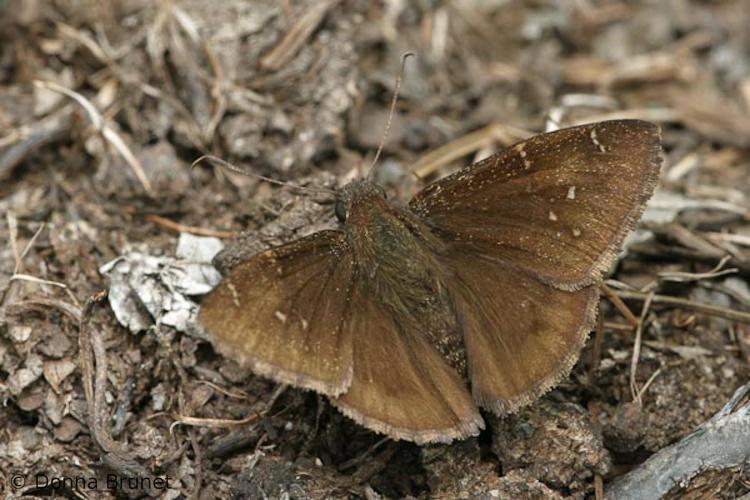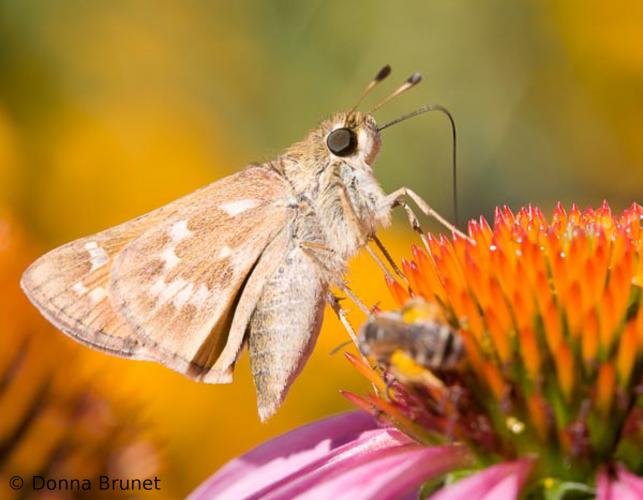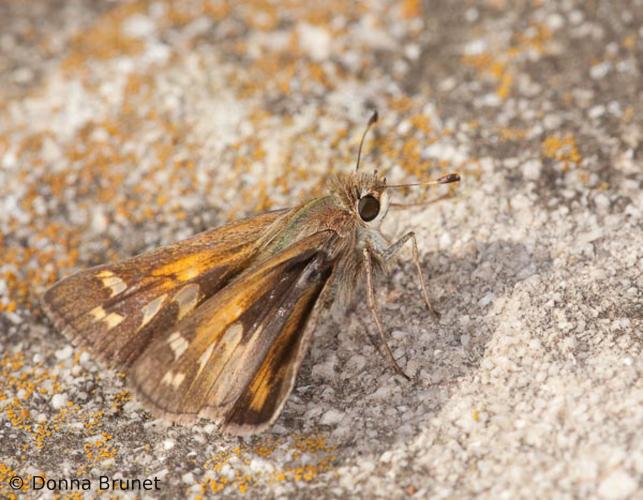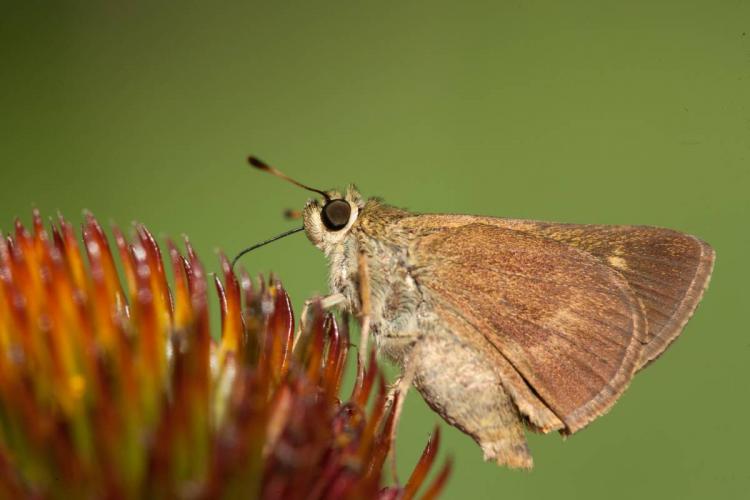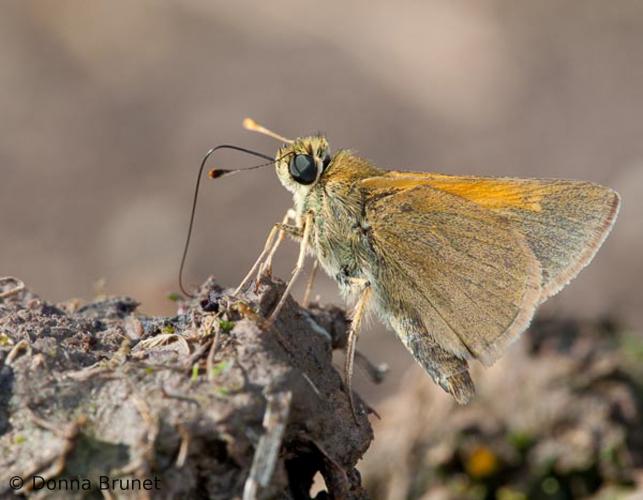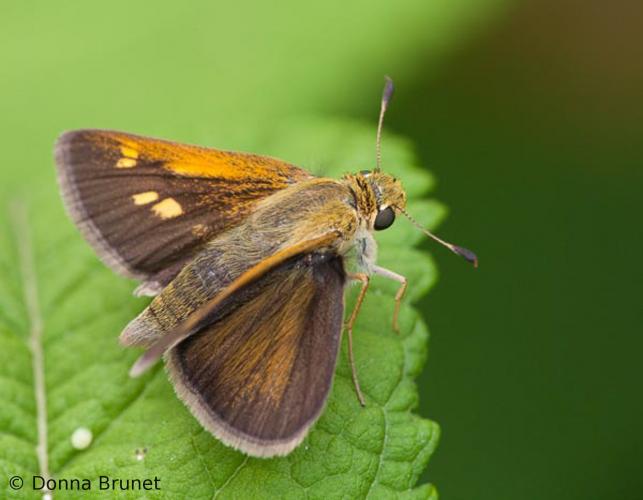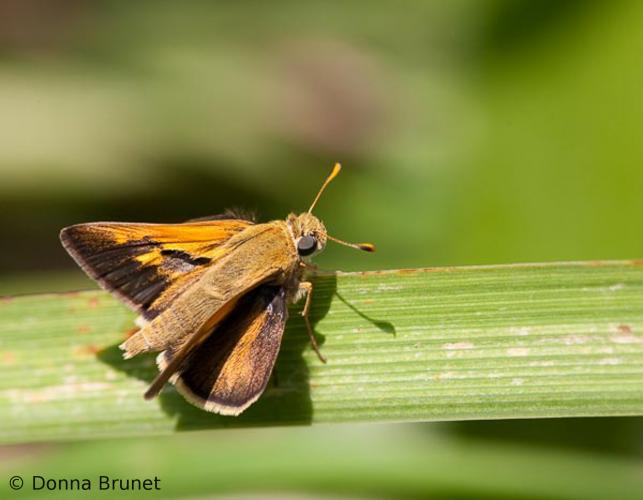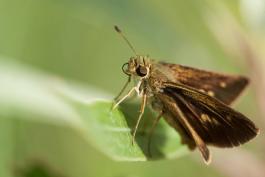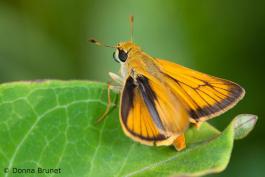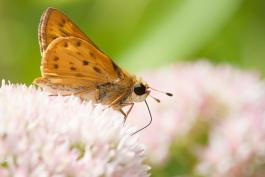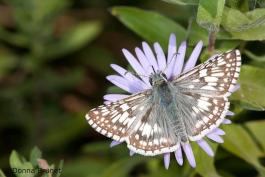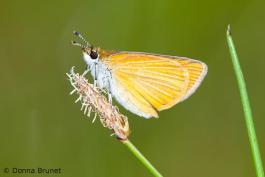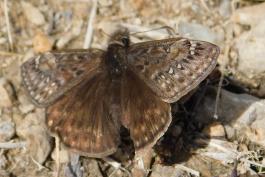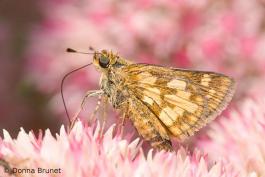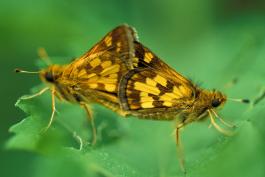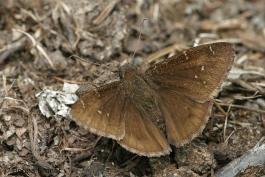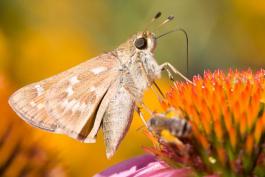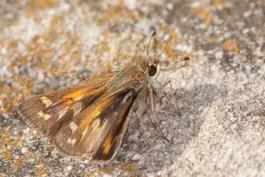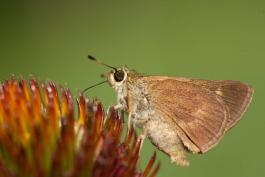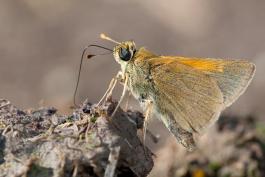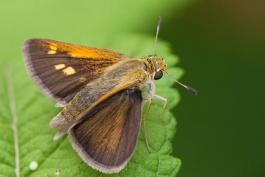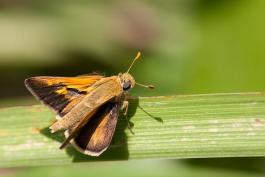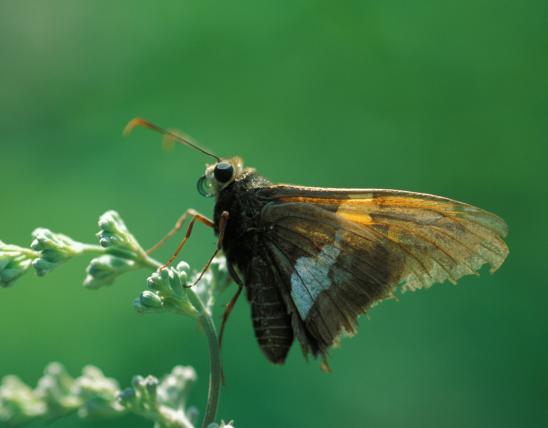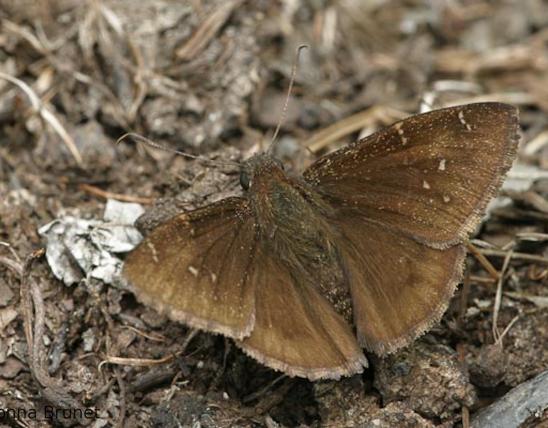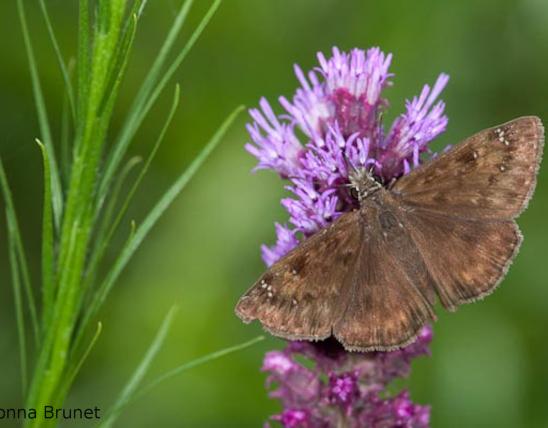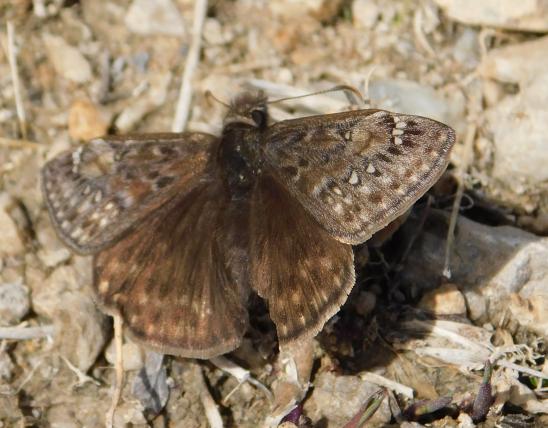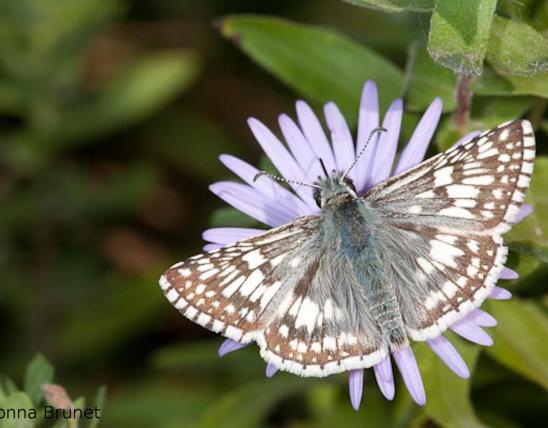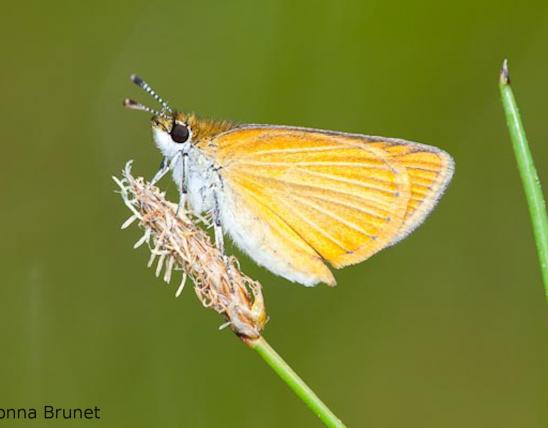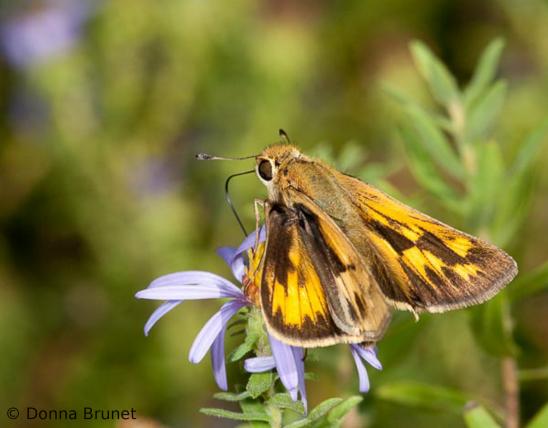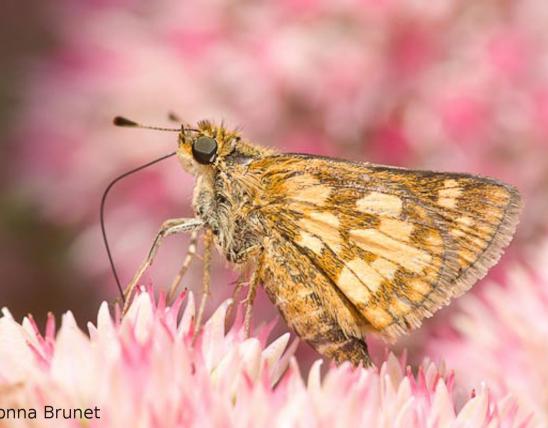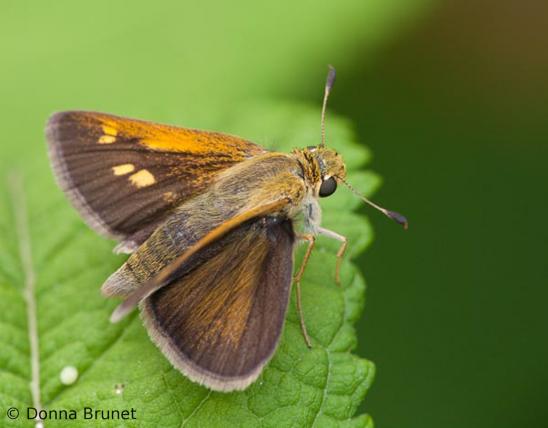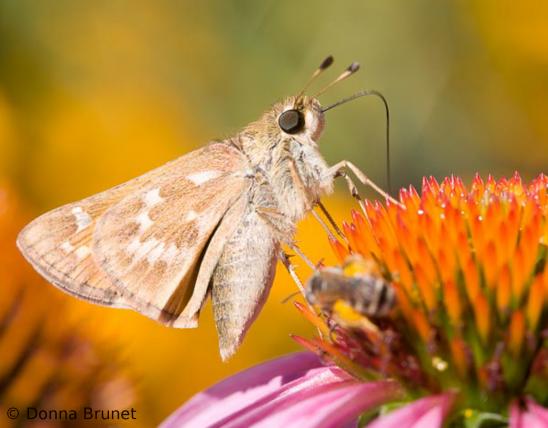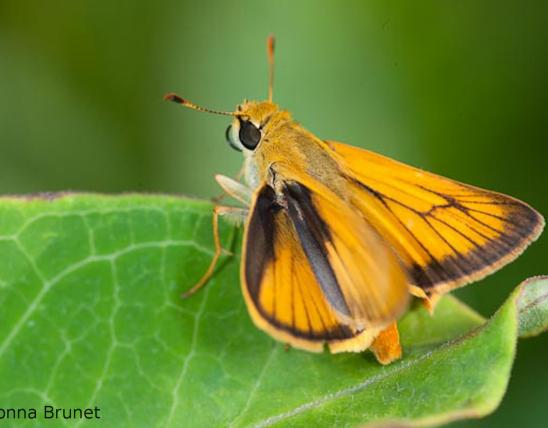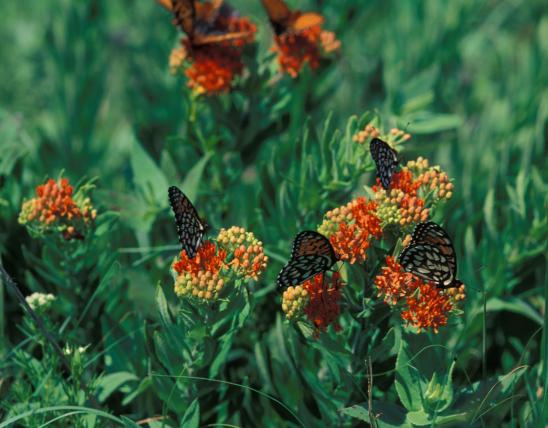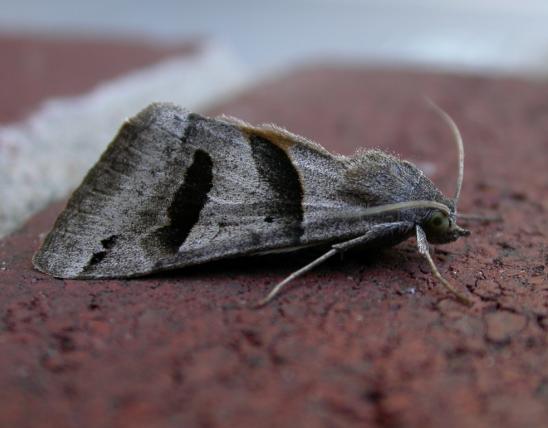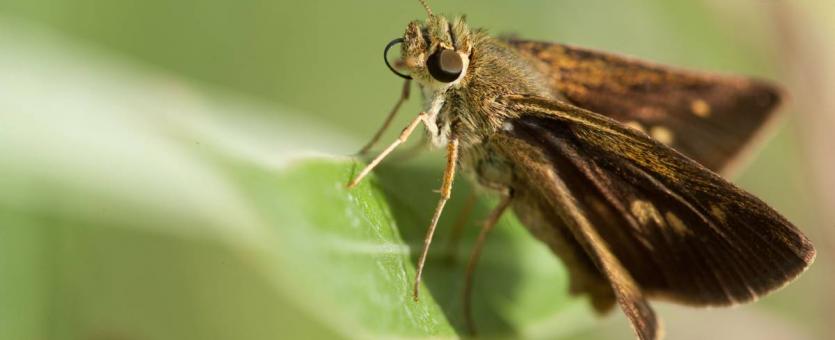
At first glance, skippers look halfway between butterflies and moths. Like other butterflies, many members of this group of small- to medium-sized butterflies are fairly colorful (especially ones that are orange or have elaborate markings), and like most other butterflies, they visit flowers and fly during the day. Also like butterflies, they have club-tipped antennae — but in nearly all skippers, each antenna tip is bent like a hook (this is a key ID character). Meanwhile, like moths, skippers have short, chunky bodies; several species are drab brown, gray, or tan; and many hold their wings flat out to the sides.
Missouri skippers can be easily divided into two general groups: spread-wing and grass skippers.
- Grass skippers, or branded skippers, hold their wings in a characteristic shape that is diagnostic for identifying to their subfamily (Hesperiinae). The forewings are held open in a V shape while the hindwings are held out horizontally (flat) to the side. One author described this as a “jet-plane” shape. Grass skippers may also fold all four wings together so that only the ventral (lower) surfaces are visible. The males of many species have a dark, usually angular patch (called a stigma or a “brand”) on the forewings — the stigma has modified scales that produce pheromones (scents) for attracting females. There are about 130–140 species of grass skippers in North America north of Mexico.
- Examples of Missouri grass skippers include the least, fiery, Leonard’s, cobweb, byssus, Peck’s, tawny-edged, crossline, Delaware, Hobomok, and dun skippers, the sachem, and the common roadside-skipper.
- Spread-wing skippers (or open-winged skippers, subfamilies Pyrginae and Eudaminae) generally land with their wings held out flat to the sides. Although sometimes they have all four wings in a slight V, they never hold their wings in the position used by grass skippers, and only rarely hold all four folded together so that only the lower surface is visible. There are about 100 species in these two subfamilies in North America north of Mexico (the spread-winged and dicot skippers used to be grouped in a single subfamily, and some references still treat them as one group).
- Examples of Missouri spread-winged skippers include Hayhurst’s scallopwing, common checkered skipper, common sootywing, and sleepy, Juvenal’s, and Horace’s duskywings
- Examples of Missouri dicot skippers (formerly grouped with the spread-winged skippers) include the silver-spotted skipper, hoary edge, and southern and northern cloudywings.
Larvae: Skipper caterpillars have a remarkably large head, compared to the width of their bodies. Often the head is darker colored than the rest of the body. Just behind the head, their bodies are extra narrowed, which accentuates the head even more. Mostly, they are green, tan, gray, or beige, with no or few hairs.
Similar species: Brush-footed butterflies (family Nymphalidae) only walk on 4 legs as adults, while skippers walk on all 6. Geometrid moths (family Geometridae) typically hold their wings flat and out to the sides, much like the spread-wing skippers, but geometrids usually have rather narrow, not chunky bodies, and they lack the skippers’ distinctive hook-clubbed antennae.
Wingspan: usually less than 1¼ inches (grass skippers); spread-winged skippers can be larger.
Statewide. Different species are associated with different habitats — with some tolerating a wide variety of habitats, and others being restricted to distinct habitat types — so they have their own distributions within the state.
Habitat and Conservation
Many Missouri species are found in locally abundant places or scattered localities near their favorite food plants. Since some food plants are located mainly in native tallgrass prairies, the skippers that feed on them form colonies in those limited habitats. Other species, which feed on a wide variety of plants, are more widespread.
Skipper larvae are rarely seen, because they typically roll leaves into shelters and tack them closed with a bit of silk, or else they join a few leaves together and hide within.
Food
The larvae of grass skippers typically feed on grasses and sedges, while the larvae of spread-winged skippers typically feed on forbs (broad-leaved wildflowers and other herbaceous plants, such as legumes or mallows) or on the leaves of woody plants such as oaks.
Some species are able to eat a rather wide variety of species, while others are more limited. The arogos skipper, for example, is not just limited to eating grasses as a caterpillar; it is pretty much limited specifically to big bluestem and little bluestem grasses, and this is why its populations occur only in native prairie habitats. The dion skipper's caterpillars eat only sedges, and they occur mostly along the Missouri and Mississippi rivers.
Adults take nectar from flowers using their extra-long proboscises (“tongues”), and it’s near flowers where most people see skippers. Skippers also commonly “puddle,” drinking moisture from mud puddles or stream banks, or even take moisture and minerals from bird droppings.
Status
At least three skippers are Missouri Species of Conservation Concern:
- Linda’s roadside-skipper (Amblyscirtes linda), an Ozark native that’s rare everywhere it occurs, and Missouri holds most of its population
- Dukes’s skipper (Euphyes dukesi), rare and local everywhere it occurs, with three very-separated populations in the eastern US
- Ottoe skipper (Hesperia ottoe), which requires high-quality tallgrass prairies.
Dukes’s and Ottoe skippers are both considered critically imperiled, which is the last step before being listed as “threatened.”
Taxonomy: In the past, skippers and butterflies each had their own superfamily within order Lepidoptera (the butterfly, skipper, and moth order). Biologists have fine-tuned their understanding of the relationships among these groups, and now skippers are just one of six families within the butterfly superfamily. So now, superfamily Papilionoidea is defined not just as “the true butterflies,” but as “the butterflies and skippers.” If you really want your mind to hurt, you can consider that the butterfly and skipper superfamily is just one of more than 30 superfamilies in the North American Lepidoptera, which comprise nearly 13,000 species. All the other superfamilies are groups of moth families.
Life Cycle
Many skippers have multiple broods, while some have only one generation a year. Like other butterflies, skippers hatch from eggs as caterpillars. The caterpillars grow and molt a number of times. When fully grown, the caterpillar pupates and emerges as a winged adult. Female skippers typically lay eggs singly on or near suitable host plants. Grass skipper caterpillars build shelters by rolling blades of grass around their bodies; this is how they spend the winter.
In some species, male skippers stake out a territory, perching on a prominent object and waiting for females to fly near. In other species, males seek females by patrolling an area. Male grass skippers are often seen fluttering rapidly around females, wafting the pheromones from the stigma patches on their wings, in their attempts to woo potential mates. Males also often dash out to inspect and drive away potential intruders.
Some skippers, though they may breed in our state during the summer, cannot survive Missouri winters. The sachem and fiery skipper are examples. They must recolonize our state each year, as populations that survive winters to our south gradually expand their ranges northward over the spring and summer.
Human Connections
Most skipper species are not economically important, even though their caterpillars eat plants.
Many skippers have creative names derived from Greek or Roman mythology or other Classical literature. The entomologists who named them in the 1800s had educations that emphasized ancient literature.
Butterfly gardening is increasingly popular, and native plants can be a big part of the plan. Skippers and other butterflies benefit, while we have fun watching and photographing them.
Butterfly watching, and butterfly photography is a “thing.” Many point-and-shoot cameras can capture surprisingly good close-up images of these living jewels.
We associate skippers with carefree summer days . . . sun-kissed grasslands full of wildflowers . . . gardens bright with zinnias, sunflowers, and marigolds . . . and lazy walks on dusty country roads, where flowers bloom freely in fencerow thickets.
Ecosystem Connections
A skipper’s chunky thorax houses robust muscles for operating the wings, which helps explain their mastery of fast flight. For skippers, flight is essential for survival (escaping predators) as well as for reproduction (chasing away rivals, patrolling for potential mates).
Many predators eat skippers, including birds, mammals, reptiles, and amphibians. A skipper that falls into a lake may be eaten by a fish. But hiding in the centers of the flowers they visit are crab spiders, ambush bugs, praying mantises, and other predators that are just as hungry.
The byssus, Ottoe, and arogos skippers have localized populations limited to high-quality native prairie habitats. That several of our skippers are strongly associated with native prairies is a reminder that prairie conservation is important not just for us but for other organisms, too.
Aerodynamically, a skipper’s rounded and shorter wings are less efficient for long distances and better for short, quick, darting flights. Compare skipper wings with, say, those of monarch butterflies, which migrate to Mexico. Then, think about the long, pointed wings of geese, which migrate across continents, and the short, rounded wings of turkeys, which can clap themselves quickly into a tree.
